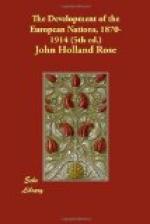After the sun passed his zenith the enemy began to press on the front and flanks. Burrows swung round his wings to meet these threatening moves; but, as the feline and predatory instincts of the Afghans kindled more and more at the sight of the weak, bent, and stationary line, so too the morale of the defenders fell. The British and Indian troops alike were exhausted by the long march and by the torments of thirst in the sultry heat. Under the fire of the Afghan cannon and the frontal and flank advance of the enemy, the line began to waver about 2 P.M., and two of the foremost guns were lost. A native regiment in the centre, Jacob’s Rifles, fled in utter confusion and spread disorder on the flanks, where the 1st Bombay Grenadiers and the 66th line regiment had long maintained a desperate fight. General Nuttall now ordered several squadrons of the 3rd Light Cavalry and 3rd Sind Horse to recover the guns and stay the onrushing tide, but their numbers were too small for the task, and the charge was not pressed home. Finally the whole mass of pursued and pursuers rolled towards the village of Khig and its outlying enclosures.
There a final stand was made. Colonel Galbraith and about one hundred officers and men of the 66th threw themselves into a garden enclosure, plied the enemy fiercely with bullets, and time after time beat back every rush of the ghazis, now rioting in that carnival of death. Surrounded by the flood of the Afghan advance, the little band fought on, hopeless of life, but determined to uphold to the last the honour of their flag and country. At last only eleven were left. These heroes determined to die in the open; charging out on the masses around, they formed square, and back to back stood firing on the foe. Not until the last of them fell under the Afghan rifles did the ghazis venture to close in with their knives, so dauntless had been the bearing of this band[322].
[Footnote 322: Report of General Primrose in Parl. Papers, Afghanistan, No. 3 (1880), p. 156.]
They had not fought in vain. Their stubborn stand held back the Afghan pursuit and gave time for the fugitives to come together on the way back to Candahar. Had the pursuit been pushed on with vigour few, if any, could have survived. Even so, Maiwand was one of the gravest disasters ever sustained by our Indian army. It cost Burrows’ force nearly half its numbers; 934 officers and men were killed




